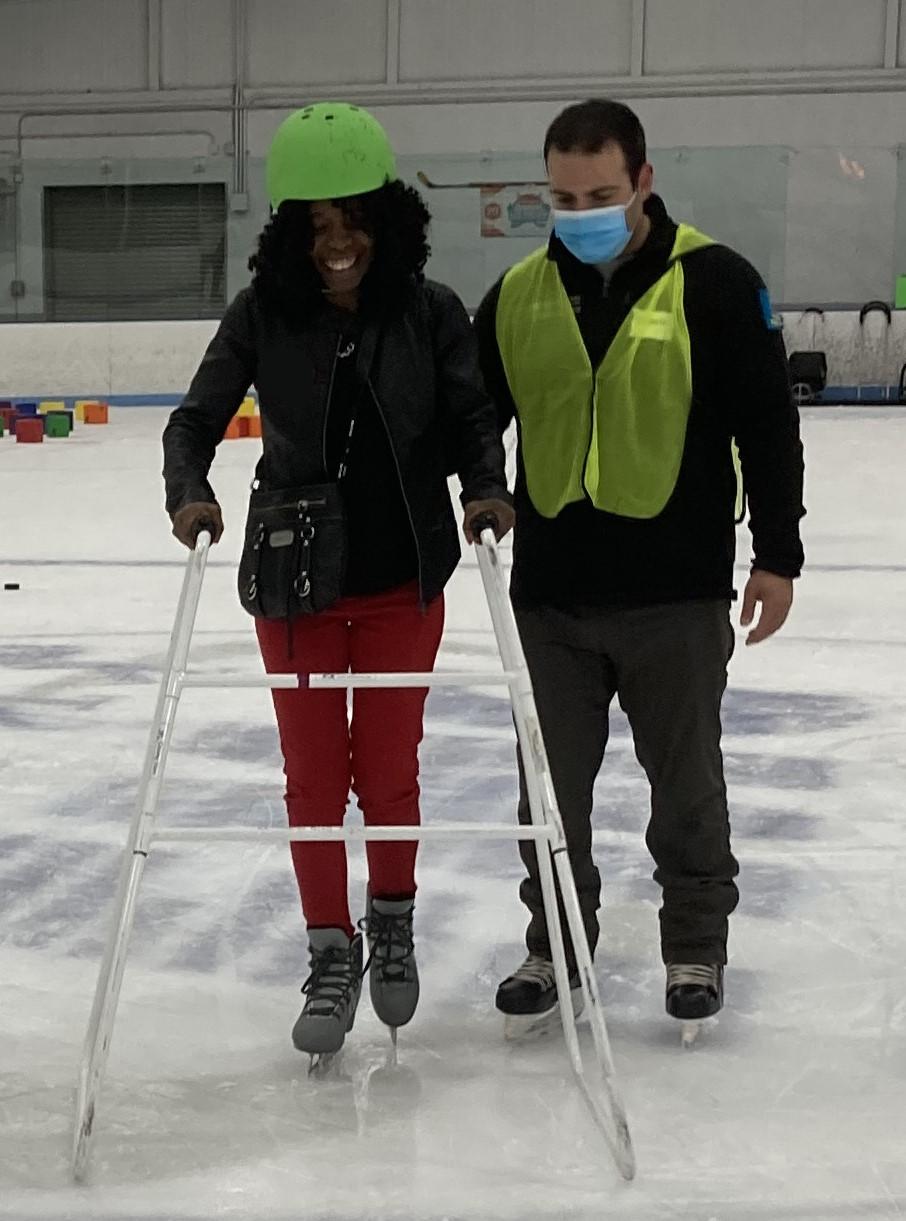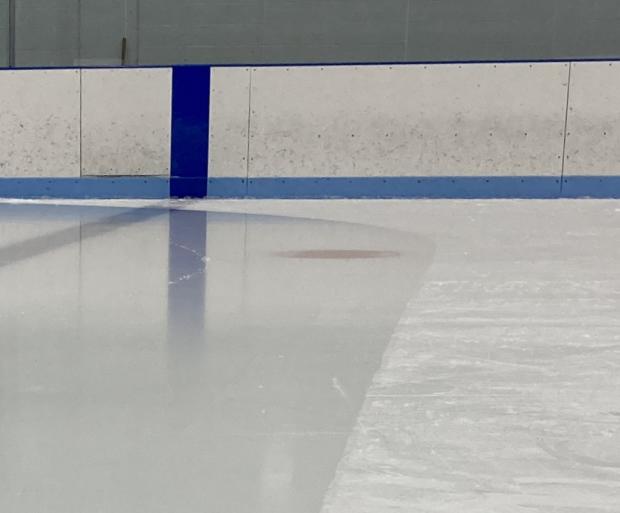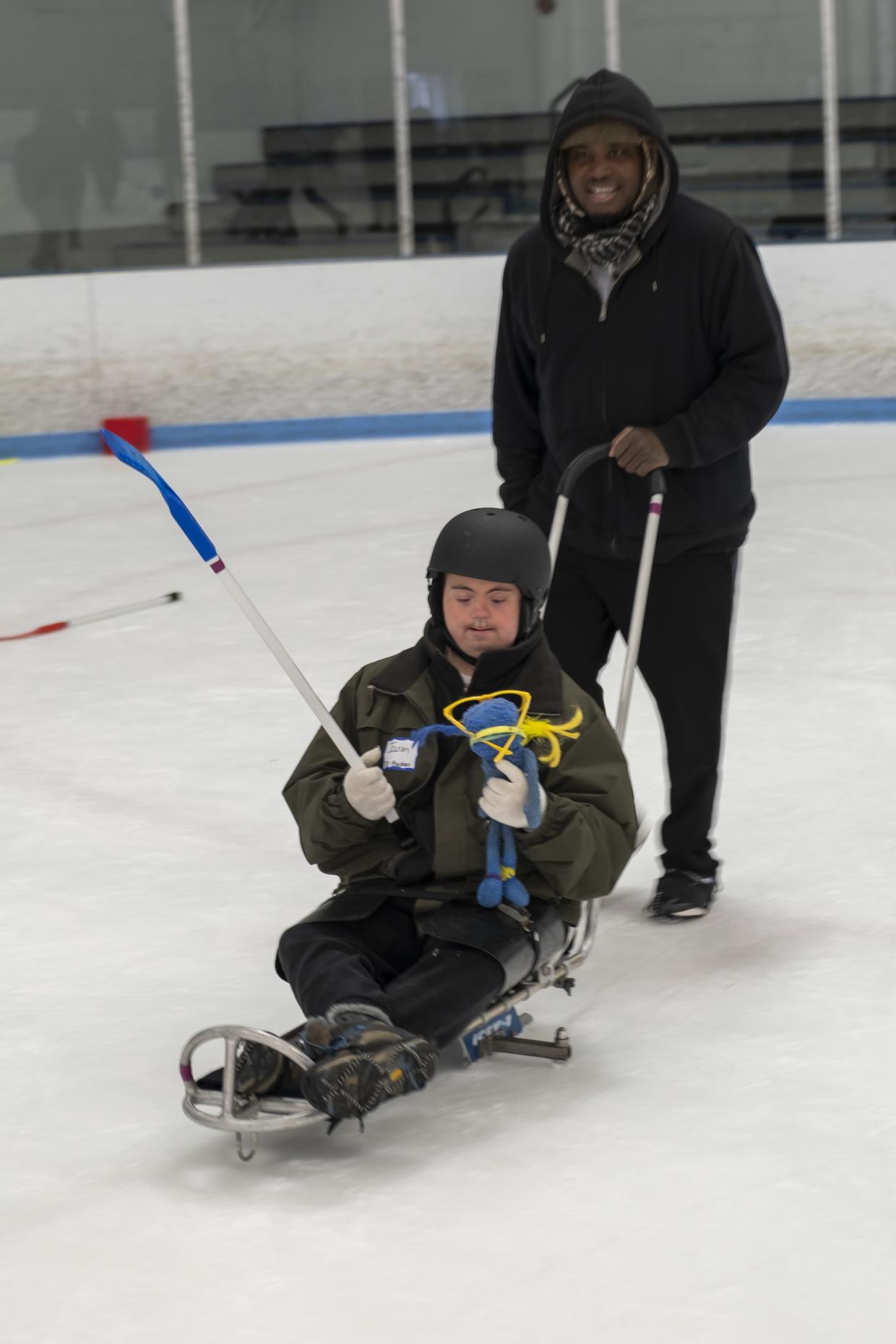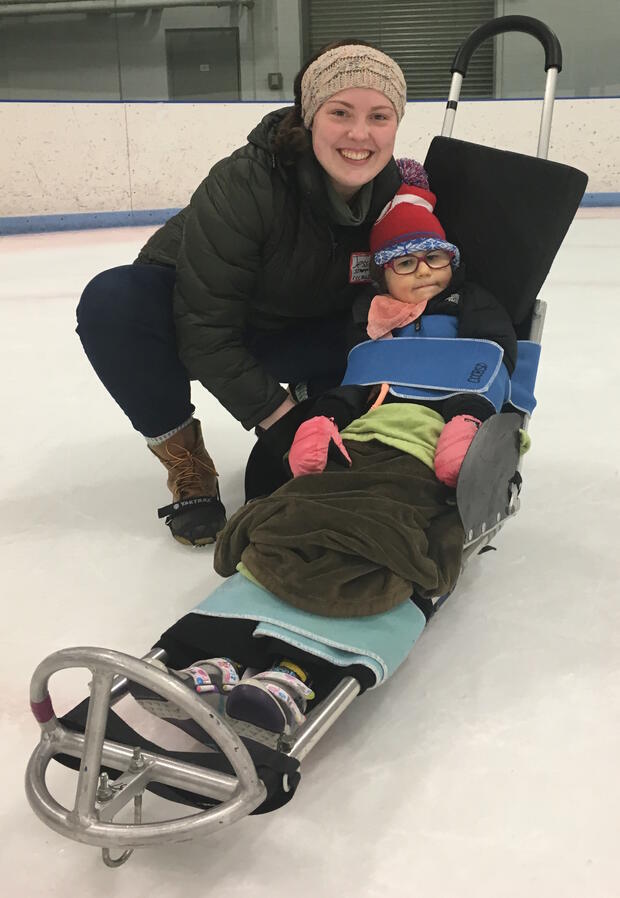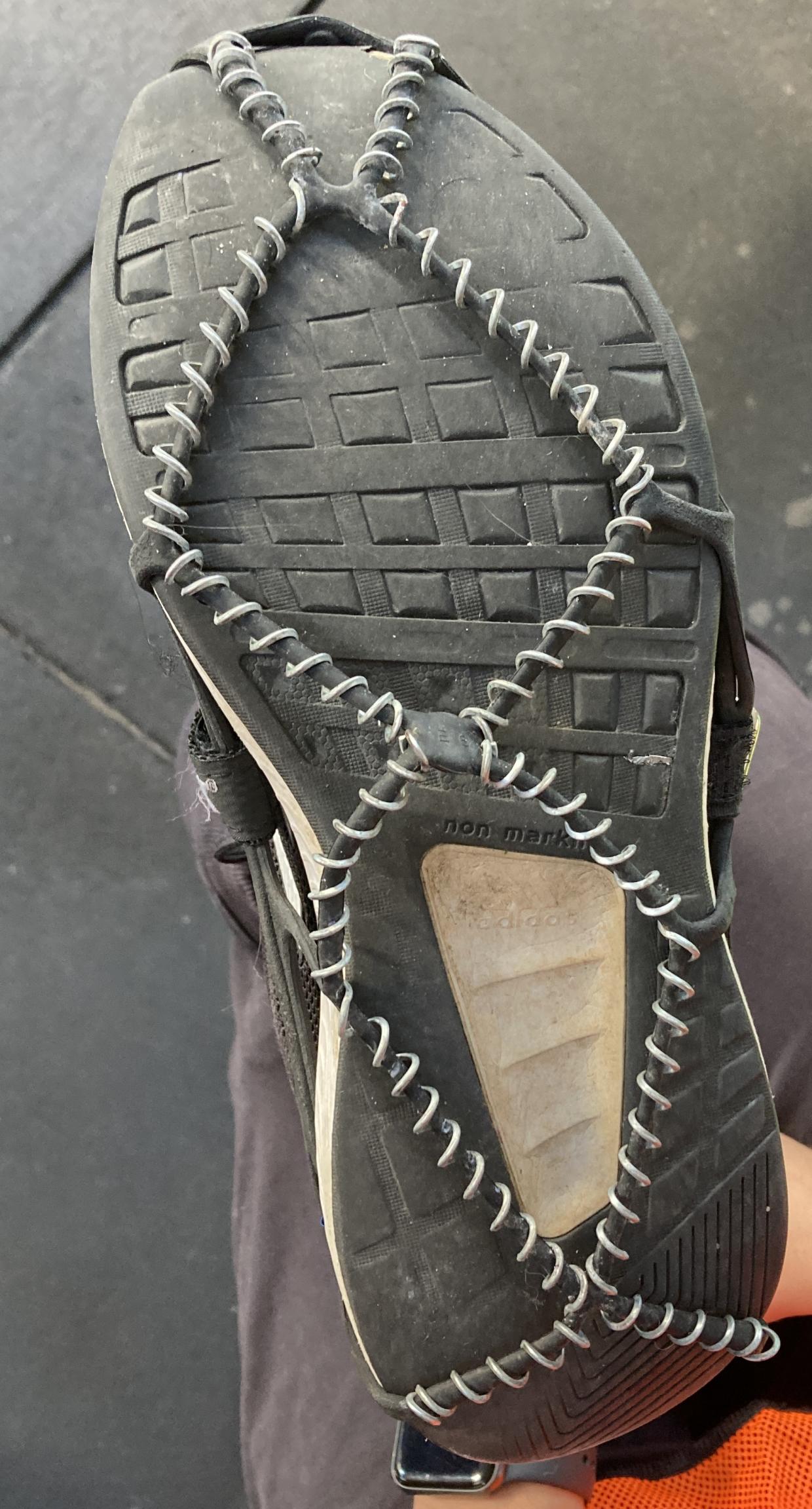What to expect
There is no charge to attend our skating programs, but you will need to pre-register with the organization that is offering the session you are interested in. Pre-registration is the time to check in with the program providers about any limitations or needs you have enjoy skating. You will also learn about the skills you need to ice skate that are outlined in our essential eligibility criteria for ice skating indoors, and learn about our program attendance guidelines. You will also fill out a release form. If you will need transfer help from our staff, please mention this at pre-registration to work out a transfer plan.
On the day of your session, you should come dressed for the cold. Even if it is warm outside, the temperatures in the rink are right around freezing, usually 20–40 degrees Fahrenheit. You should dress in multiple layers, especially on top, and bring gloves or mittens if you have them. You'll want long pants you can easily move in, and if you're wearing a skirt, you should have pants or thick leggings underneath. You should also wear a winter coat if you have one. Your socks should be warm and comfortable, and if you're going to wear ice skates, not too thick.
If you are going to stay in your wheelchair or sit in an ice sled, you can also bring a blanket or sleeping bag to tuck around you for extra warmth. Or, you can use one of our blankets.
If you are bringing a companion, PCA, or group staff with you, they will also need to meet the essential eligibility criteria, follow our program attendance guidelines, and fill out a release form. Your companion should be prepared to stay with you on the ice and transfer you independently, or in accordance with the transfer plan you established with the program operator during pre-registration.
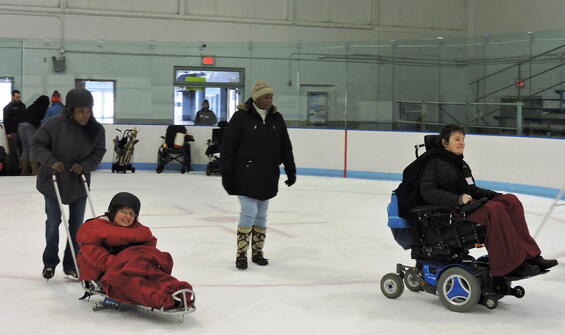
These skaters are dressed warmly for the rink. The seated skaters are using blankets on their legs for extra warmth.
If you are going to walk on the ice with ice grippers on your shoes, your shoes should be comfortable and sturdy with a flat sole. Sneakers and boots are good choices. You can't wear scuffs, slippers, sandals, high heels, or heeled boots on the ice.
We encourage everyone on the ice to wear a helmet, especially if you're on the ice for the first time or if you are using a balance aid. Helmets are a standard part of equipment for beginning skaters! Our helmets are padded and warm, and you will need to take your hat off before you put a helmet on. You may also need to take your hair down if it is up in a bun or a ponytail.
Once you have your helmet on, you can enjoy open recreation time on the ice. We have experienced skaters who can help you learn how to move and play on the ice and give you some tips and pointers for skating, but we don't offer full skating lessons. There are many great resources online to learn to skate that are aimed at beginners or those who haven't skated in a long time. Many rinks also offer learn to skate programs.
Play and games
Our skating programs are focused on games and play. Moving around on the ice is fun and spontaneous, and you can invent fun new things to try!
Two thirds of the rink has a shaved surface to give you better traction. The last third is polished smooth for easier and faster skating. You can use any piece of equipment on any part of the ice, and see which surface feels better to you.
We have hockey sticks of different sizes, and balls, pucks, and cubes of different sizes and colors. You can practice passing a puck or a ball, or making a shot on the goal. Or, get a few friends together for a gentle game of hockey.
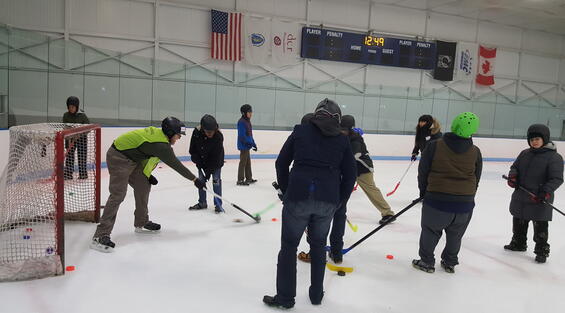
These skaters are taking shots at the goal.
You can challenge a friend to a gently competitive race in a sled or on skates, or set up some cones in a slalom and challenge yourself to swerve around them.
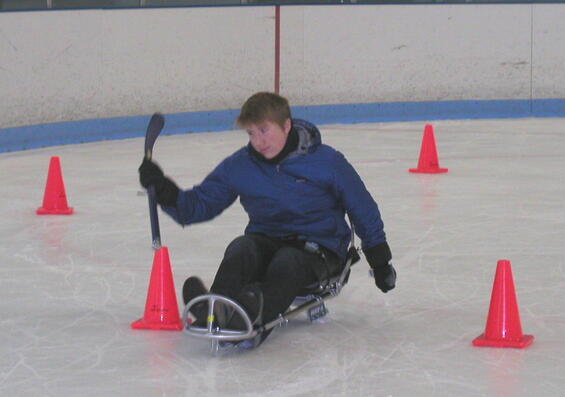
This sled skater is making a tight turn around a cone.
Our foam blocks are great for building towers or forts. After you've built them up, you can knock them down again by hitting them with a puck or a ball, or crashing right through the stack.
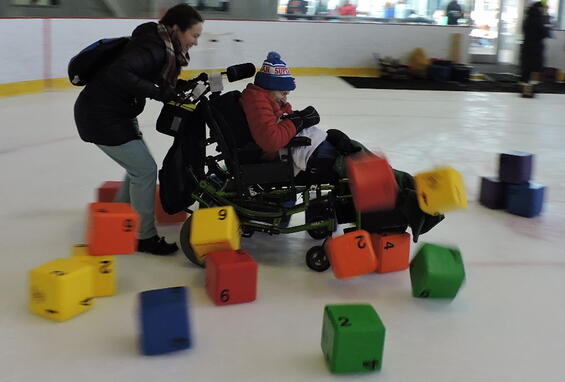
Crashing through a tower of blocks.
The possibilities on the ice are limited only by your imagination, so feel free to explore and come up with new things to try!
This skater is using their chair to tow another skater across the ice.
Ice sleds
Seated ice sleds let skaters of all abilities have fun on the ice. The sleds are popular with wheelchair users, and also with ambulatory skaters with balance issues or fatigue. They are also a fun way to switch up your skating style and explore new ways to move and play on the ice.
The sleds have anti-tippers to prevent you from tipping over backwards. The blades on our sleds are set wide for extra stability, and some sleds also have outriggers for even more support on turns.
The sleds come in a variety of sizes and styles for both adults and children, and have leg trays that adjust for your height.. Some sleds have narrow seats with low backs for greater maneuverability, and others have large bucket seats with back support for more support and stability. You can use our foam wedges and bolsters to get the right amount of support in your sled.
You can attach handles to the back of the ice sled and have someone else push you if you can’t push or steer, or you can push yourself across the ice using two short hockey sticks with a figure skating pick on the ends. if you're planning on pushing yourself, it's a good idea to wear gloves to keep your hands warm since they'll be so close to the ice.
There's a dedicated sled area at our programs to get on and off the sleds, with transfer assistance if needed, and to launch onto the ice from a non-slippery surface.
Skate walkers
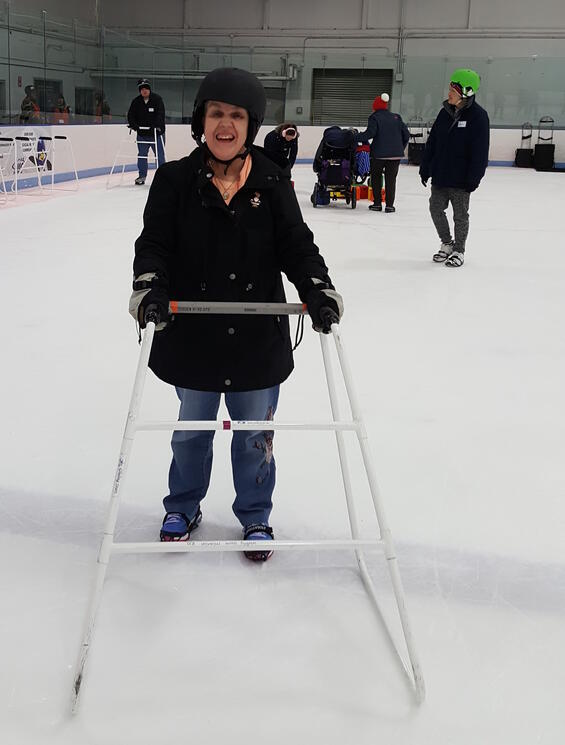
This skater is using ice grippers and a walker with a bar across the back.
Skate walkers can be used to help you balance while you are standing on the ice, either alone or with a companion guiding you along and supporting you. They can be used with ice skates or with ice grippers on your feet. At our programs, we ask people who are using a skate walker to balance to wear a helmet while using them.
The metal skate walkers we use at our programs have a stable design with a wide base that stays in position while you are using it, and folds away for transport. There are foam handles that offer cushioned support for your hands and keep them off of the cold metal.
The walkers come in three sizes to work with skaters of different heights. One of our walkers has forearm supports so that you can keep your hands and shoulders in a neutral position while using the walker.
The walkers are designed to be pushed in front of you so that you keep your weight forward over your feet. They aren't designed to support your weight, and you can slip if you walk too far into the walker so that your hips are ahead of your shoulders. When using a walker, you'll want to make sure to learn forward a little and keep the walker in front of you. You can add a bar or strap across the back of the walker to help keep the walker in front of you so it is in the right spot for balancing. You can also use a gait belt with a companion to help you keep your balance. The gait belt buckles around your waist and has handles for your companion to hold on to.
Ice grippers
If you want to walk on the ice instead of skate, you can use ice grippers on your shoes. The grippers stretch over the bottom of your shoes, and the metal spirals give you extra traction to keep from slipping on the ice. You can use the ice grippers together with a skate walker, or on their own.
Skating program locations and schedule
Our adaptive skating programs are offered November through March at rinks across the state. To learn about upcoming programs, email us to get on our mailing list. To see the current program schedule, please visit our adaptive program schedule.
